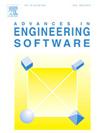Deep neural network based head injury criterion estimation for more efficient pedestrian protection performance evaluation in bonnet structure design
IF 4
2区 工程技术
Q2 COMPUTER SCIENCE, INTERDISCIPLINARY APPLICATIONS
引用次数: 0
Abstract
In the early development stage of a new car model, fast evaluation of pedestrian protection performance is required to accelerate the bonnet structure design process. Current evaluation methods rely on finite element (FE) simulation to calculate the Head Injury Criterion (HIC) values at specified points on the bonnet, before proceeding to the more expensive real-world impact test using headform impactors. However, the FE based approach typically takes several days to complete the meshing, boundary condition setting and HIC calculation to evaluate a single design candidate. To further increase the evaluation efficiency, this paper presents a novel HIC estimation approach based on deep learning. An end-to-end deep neural network model is proposed which can directly generate the HIC value without resorting to FE methods. It uses seven variables pertaining to the panel height, structural difference, thickness and head type as the input based on the definition of HIC. Convolution layers are utilised to aggregate the surrounding structural information for each target point. To demonstrate the effectiveness of the proposed approach, cross validation results are presented based on a dataset of over five thousands target points collected from 28 cars. For the green target regions, the average HIC estimation accuracy is 93.1 %, which outperforms the result of 83 % reported in previous work. A comparison with the traditional support vector regression method demonstrates the advantages of the proposed approach.
求助全文
约1分钟内获得全文
求助全文
来源期刊

Advances in Engineering Software
工程技术-计算机:跨学科应用
CiteScore
7.70
自引率
4.20%
发文量
169
审稿时长
37 days
期刊介绍:
The objective of this journal is to communicate recent and projected advances in computer-based engineering techniques. The fields covered include mechanical, aerospace, civil and environmental engineering, with an emphasis on research and development leading to practical problem-solving.
The scope of the journal includes:
• Innovative computational strategies and numerical algorithms for large-scale engineering problems
• Analysis and simulation techniques and systems
• Model and mesh generation
• Control of the accuracy, stability and efficiency of computational process
• Exploitation of new computing environments (eg distributed hetergeneous and collaborative computing)
• Advanced visualization techniques, virtual environments and prototyping
• Applications of AI, knowledge-based systems, computational intelligence, including fuzzy logic, neural networks and evolutionary computations
• Application of object-oriented technology to engineering problems
• Intelligent human computer interfaces
• Design automation, multidisciplinary design and optimization
• CAD, CAE and integrated process and product development systems
• Quality and reliability.
 求助内容:
求助内容: 应助结果提醒方式:
应助结果提醒方式:


